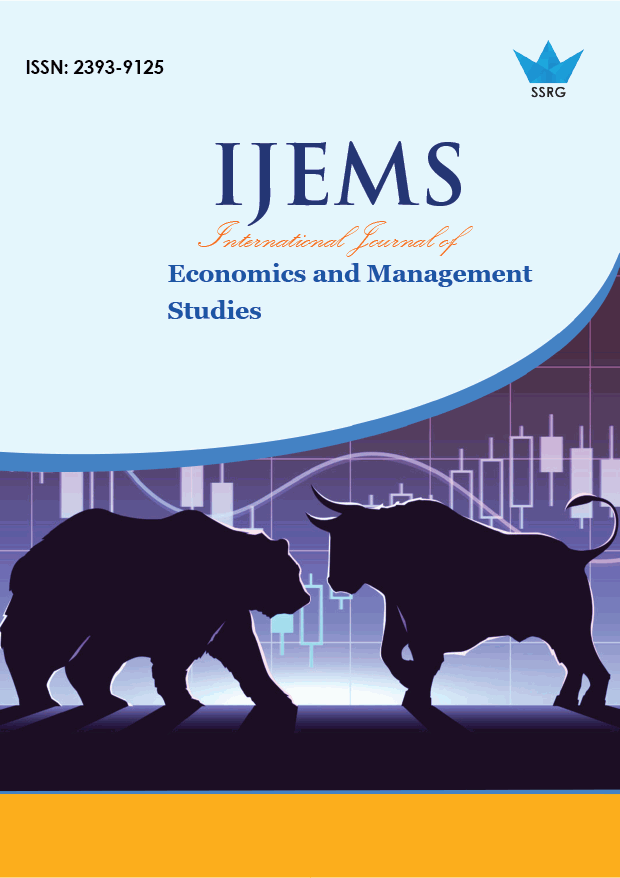Sustainable Finance: Assessing Environmental, Social, and Governance (ESG) Factors in Investment Decisions

| International Journal of Economics and Management Studies |
| © 2024 by SSRG - IJEMS Journal |
| Volume 11 Issue 6 |
| Year of Publication : 2024 |
| Authors : Hari Prasad Josyula, Manoj Kumar Vandanapu |
How to Cite?
Hari Prasad Josyula, Manoj Kumar Vandanapu, "Sustainable Finance: Assessing Environmental, Social, and Governance (ESG) Factors in Investment Decisions," SSRG International Journal of Economics and Management Studies, vol. 11, no. 6, pp. 7-14, 2024. Crossref, https://doi.org/10.14445/23939125/IJEMS-V11I6P102
Abstract:
Sustainable finance, driven by the integration of Environmental, Social, and Governance (ESG) factors, has emerged as a critical paradigm in contemporary investment decision-making. This review paper critically assesses the role and impact of sustainable finance, focusing on how ESG considerations influence investment strategies, risk management, and financial performance. The paper begins by providing a comprehensive overview of the conceptual underpinnings of sustainable finance, elucidating the significance of ESG criteria in evaluating the long-term sustainability and ethical implications of investments. A critical examination of the environmental dimension of sustainable finance delves into the assessment of climate-related risks, resource efficiency, and the promotion of environmentally friendly practices within investment portfolios. The review synthesizes empirical evidence on the financial performance of sustainable investments, exploring the relationship between ESG factors and risk-adjusted returns. It investigates the emergence of sustainable indices and the growing demand for impact investments, reflecting a shift in investor preferences towards socially responsible and environmentally conscious portfolios. The paper underscores the potential of sustainable finance in reshaping global capital markets toward more ethical, resilient, and responsible investment practices. It calls for continued research, collaboration, and policy initiatives in mainstream investment decision-making, promoting a more sustainable and equitable financial landscape.
Keywords:
ESG, Ethical Business Practices, Impact investing, Risk management.
References:
[1] Gordon L. Clark, Andreas Feiner, and Michael Viehs, “From the Stockholder to the Stakeholder: How Sustainability Can Drive Financial Outperformance,” SSRN, pp. 1-66, 2015.
[CrossRef] [Google Scholar] [Publisher Link]
[2] Bert Scholtens, and Feng-Ching Kang, “Corporate Social Responsibility and Earnings Management: Evidence From Asian Economies,” Corporate Social Responsibility and Environmental Management, vol. 20, no. 2, pp. 95-112, 2013.
[CrossRef] [Google Scholar] [Publisher Link]
[3] G. Giese, and B. Scholtens, “A Review of Sustainable Investment Research,” Oxford Review of Economic Policy, vol. 30, no. 1, pp. 201-222, 2014.
[4] M. Dembiermont, and C. Van Hulle, Integrating Sustainability in Prudential Regulation and Supervision, European Banking Authority, 2015. Online. [Available]: https://www.eba.europa.eu/sites/default/documents/files/documents/10180/1103444/06f6882a-4c15-4cbf-9641-cbba6e1fe185.pdf
[5] M. Khan, The Need for a Global Standard on Sustainability Disclosure, International Finance Corporation (IFC), 2018. Online. [Available]: https://www.ifc.org/wps/wcm/connect/9735ba7d-6695-460e-980a-5b76b7c48a04/EMCom+2018+Papers+PDF_Art6_Khan.pdf?MOD=AJPERES&CVID=l.cjy0l
[6] Rob Bauer, Kees Koedijk, and Rogér Otten, “International Evidence on Ethical Mutual Fund Performance and Investment Style,” Journal of Banking & Finance, vol. 29, no. 7, pp. 1751-1767, 2005.
[CrossRef] [Google Scholar] [Publisher Link]
[7] Luc Renneboog, Jenke Ter Horst, and Chendi Zhang, “Socially Responsible Investments: Institutional Aspects, Performance, and Investor Behavior,” Journal of Banking & Finance, vol. 32, no. 9, pp. 1723-1742, 2008.
[CrossRef] [Google Scholar] [Publisher Link]
[8] Harrison Hong, Jeffrey D. Kubik, and Amit Solomon, “Security Analysts’ Career Concerns and Herding of Earnings Forecasts,” The RAND Journal of Economics, vol. 31, no. 1, pp. 121-144, 2000.
[Google Scholar] [Publisher Link]
[9] Dan S. Dhaliwal et al., “Voluntary Nonfinancial Disclosure and the Cost of Equity Capital: The Initiation of Corporate Social Responsibility Reporting,” The Accounting Review, vol. 86, no. 1, pp. 59-100, 2011.
[CrossRef] [Google Scholar] [Publisher Link]
[10] Harrison Hong, and Marcin Kacperczyk, “The Price of Sin: The Effects of Social Norms on Markets,” Journal of Financial Economics, vol. 93, no. 1, pp. 15-36, 2009.
[CrossRef] [Google Scholar] [Publisher Link]
[11] Robert G. Eccles, Ioannis Ioannou, and George Serafeim, “The Impact of Corporate Sustainability on Organizational Processes and Performance,” Management Science, vol. 60, no. 11, pp. 2835-2857, 2014.
[CrossRef] [Google Scholar] [Publisher Link]
[12] James P. Hawley, and Andrew T. Williams, The Rise of Fiduciary Capitalism: How Institutional Investors Can Make Corporate America More Democratic, University of Pennsylvania Press, 2000.
[Google Scholar] [Publisher Link]
[13] David A. Sauer, “The Impact of Social-Responsibility Screens on Investment Performance: Evidence From the Domini 400 Social Index and Domini Equity Mutual Fund,” Review of Financial Economics, vol. 6, no. 2, pp. 137-149, 1997.
[CrossRef] [Google Scholar] [Publisher Link]
[14] A. Edmans, and F. Perez-Gonzalez, “Insider trading and CEO pay,” The Journal of Finance, vol. 68, no. 2, pp. 653-687, 2013.
[15] April Klein, “Audit Committee, Board of Director Characteristics, and Earnings Management,” Journal of Accounting and Economics, vol. 33, no. 3, pp. 375-400, 2002.
[CrossRef] [Google Scholar] [Publisher Link]
[16] Karl V. Lins, Henri Servaes, and Ane Tamayo, “Social Capital, Trust, and Firm Performance: The Value of Corporate Social Responsibility During the Financial Crisis,” The Journal of Finance, vol. 72, no. 4, pp. 1785-1824, 2017.
[CrossRef] [Google Scholar] [Publisher Link]
[17] Paul Gompers, Joy Ishii, and Andrew Metrick, “Corporate Governance and Equity Prices,” The Quarterly Journal of Economics, vol. 118, no. 1, pp. 107-156, 2003.
[CrossRef] [Google Scholar] [Publisher Link]
[18] Peter Tufano, and Matthew Sevick, “Board Structure and Fee-setting in the U.S. Mutual Fund Industry,” Financial Management, vol. 46, no. 3, pp. 321-355, 1997.
[CrossRef] [Google Scholar] [Publisher Link]
[19] Joshua D. Margolis, Hillary Anger Elfenbein, and James P. Walsh, “Does it Pay to be Good... and Does it Matter? A Meta-analysis of the Relationship Between Corporate Social and Financial Performance,” SSRN, pp. 1-68, 2009.
[CrossRef] [Google Scholar] [Publisher Link]
[20] Johan Rockström et al., “A Safe Operating Space for Humanity,” Nature, vol. 461, no. 7263, pp. 472-475, 2009.
[CrossRef] [Google Scholar] [Publisher Link]

 10.14445/23939125/IJEMS-V11I6P102
10.14445/23939125/IJEMS-V11I6P102